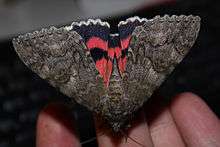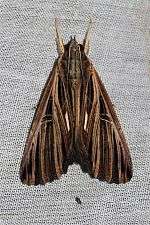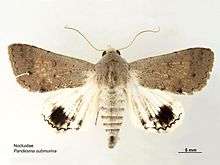Erebinae
The Erebinae are a subfamily of moths in the family Erebidae erected by William Elford Leach in 1815. Erebine moths are found on all continents except Antarctica, but reach their greatest diversity in the tropics.[1] While the exact number of species belonging to the Erebinae is not known, the subfamily is estimated to include around 10,000 species.[2] Some well-known Erebinae include underwing moths (Catocala) and witch moths (Thermesiini). Many of the species in the subfamily have medium to large wingspans (7 to 10 cm, 3 to 4 inches), up to nearly 30 cm in the white witch moth (Thysania agrippina), which has the widest wingspan of all Lepidoptera.[3] Erebine caterpillars feed on a broad range of plants; many species feed on grasses and legumes, and a few are pests of castor bean,[4] sugarcane, rice,[5] as well as pistachios [6] and blackberries.[7]
| Erebinae | |
|---|---|
 | |
| Red underwing (Catocala nupta) | |
| Scientific classification | |
| Kingdom: | Animalia |
| Phylum: | Arthropoda |
| Class: | Insecta |
| Order: | Lepidoptera |
| Superfamily: | Noctuoidea |
| Family: | Erebidae |
| Subfamily: | Erebinae Leach, [1815] |
Morphology
Erebine moths possess a number of adaptations for predator defense. Most Erebinae, such as Zale have mottled, drably colored hindwings to better blend in with grass and tree trunks. In some Erebinae, such as Catocala, cryptically colored forewings conceal brightly colored hindwings which are suddenly revealed when the moth is disturbed from rest.[8] The sudden exposure of these bright colors is thought to startle vertebrate predators, giving the moths extra time to escape.[9] Like other Noctuoidea, erebine moths can detect the calls of echolocating bats or other approaching predators using hearing organs (tympana), which are among the most sensitive in the superfamily.[10][11]
Taxonomy
Prior to recent phylogenetic studies on the superfamily Noctuoidea, most Erebinae were classified within the noctuid subfamily Catocalinae, on the basis of a classification proposed by George Hampson at the start of the 20th century.[12][13] Based on mounting evidence from molecular phylogenetic studies, Michael Fibiger and J. Donald Lafontaine[14] transferred Erebinae and relatives from the Noctuidae to the Erebidae, and reinstated Erebinae as a subfamily. Later, Catocalinae was synonymized with Erebinae in the classifications proposed by Lafontaine and Christian Schmidt[15] and Zahiri et al.[16][1] A historical summary of the systematics of this group is provided by Jeremy Daniel Holloway,[17] and a more detailed review of Erebinae taxonomy can be found in Nicholas T. Homziak et al.[18] The most recent study by Zahriri et al.[1] forms the basis for the current definition of the Erebinae. On the basis of consistent molecular support, Zahiri et al.[1] identified several potential morphological synapomorphies for the subfamily: proboscis with smooth apex and sensilla styloconica dorsally, modified seventh abdominal sternite in the female, divided in to two lobes surrounding the ostium bursae (female copulatory opening). In the larvae, dorsolateral tubercles on segment A8, and pupae often with waxy bloom. Within the Erebinae, Zahiri et al.[1] recognized the following 19 tribes:
Tribes
Genera with tribe not available:
References
| Wikimedia Commons has media related to Erebinae. |
- Zahiri, Reza; Holloway, Jeremy D.; Kitching, Ian J.; Lafontaine, J. Donald; Mutanen, Marko; Wahlberg, Niklas (2012-01-01). "Molecular phylogenetics of Erebidae (Lepidoptera, Noctuoidea)". Systematic Entomology. 37 (1): 102–124. doi:10.1111/j.1365-3113.2011.00607.x. ISSN 1365-3113.
- Kononenko, V.S. & Pinratana, A. (2013). Moths of Thailand Vol. 3, Part 2. Noctuoidea. An illustrated Catalogue of Erebidae, Nolidae, Euteliidae, and Noctuidae (Insecta: Lepidoptera) in Thailand. Bangkok: Brothers of St. Gabriel in Thailand.
- "Chapter 32: Largest Lepidopteran Wing Span | The University of Florida Book of Insect Records | Department of Entomology & Nematology | UF/IFAS". www.entnemdept.ufl.edu. Archived from the original on 2011-08-18. Retrieved 2017-04-20.
- Naik, M. I.; Ajith Kumar, M. A.; Manjunatha, M.; Shivanna, B. K. (2010). "Survey for the pests of castor and natural enemies of castor semilooper". Environment and Ecology (Kalyani). 28: 558–563.
- Zilli, A. (2000). "African-Arabian and Asian-Pacific "Mocis frugalis": two distinct species (Lepidoptera: Noctuidae)". European Journal of Entomology. 97: 419–426. doi:10.14411/eje.2000.064.
- Berlinger, M. J.; Yathom, S.; Halperin, J. (2001). "Ophiusa tirhaca Cramer (Noctuidae: Lepidoptera) infesting pistachio trees in Israel". Zoology in the Middle East. 22: 83–86. doi:10.1080/09397140.2001.10637851.
- Vázquez, Yadira-Maibeth; Martínez, Ana-Mabel; Valdez, Jorge-Manuel; Figueroa, José-Isaac; Rebollar, Ángel; Chavarrieta, Juan Manuel; Sánchez, José-Antonio; Viñuela, Elisa; Pineda, Samuel (2014-01-01). "Life History, Diagnosis, and Parasitoids of Zale phaeograpta (Lepidoptera: Erebidae)". Annals of the Entomological Society of America. 107 (1): 170–177. doi:10.1603/an13093. ISSN 0013-8746.
- Sargent, T. D. (1976). Legion of Night: The Underwing Moths. Amherst: University of Massachusetts Press. pp. xii + 222pp.
- Schlenoff, Debra H. (1985-11-01). "The startle responses of blue jays to Catocala (Lepidoptera: Noctuidae) prey models". Animal Behaviour. 33 (4): 1057–1067. doi:10.1016/S0003-3472(85)80164-0.
- Fullard, James H.; Napoleone, Nadia (2001-08-01). "Diel flight periodicity and the evolution of auditory defences in the Macrolepidoptera". Animal Behaviour. 62 (2): 349–368. doi:10.1006/anbe.2001.1753.
- Fullard, James H. (1984-11-01). "Acoustic relationships between tympanate moths and the Hawaiian hoary bat (Lasiurus cinereus semotus)". Journal of Comparative Physiology A. 155 (6): 795–801. doi:10.1007/BF00611596. ISSN 0340-7594.
- Hampson, G. F. (1913). Catalogue of the Lepidoptera Phalaenae of the British Museum. 12. London: Trustees of the British Museum. pp. 626 pp.
- Hampson, G. F. (1913). Catalogue of the Lepidoptera Phalaenae of the British Museum. 13. London: Trustees of the British Museum. pp. 609 pp.
- Fibiger, Michael; Lafontaine, J. Donald (June 29, 2005). "A review of the higher classification of the Noctuoidea (Lepidoptera) with special reference to the Holarctic fauna". Esperiana. 11: 27–28.
- Lafontaine, Donald; Schmidt, Christian (2010-03-19). "Annotated check list of the Noctuoidea (Insecta, Lepidoptera) of North America north of Mexico". ZooKeys. 40: 1–239. doi:10.3897/zookeys.40.414. ISSN 1313-2970.
- Zahiri, Reza; Kitching, Ian J.; Lafontaine, J. Donald; Mutanen, Marko; Kaila, Lauri; Holloway, Jeremy D.; Wahlberg, Niklas (2011-03-01). "A new molecular phylogeny offers hope for a stable family level classification of the Noctuoidea (Lepidoptera)". Zoologica Scripta. 40 (2): 158–173. doi:10.1111/j.1463-6409.2010.00459.x. ISSN 1463-6409.
- Holloway, J. D. "The Moths of Borneo Parts 15&16: Family Noctuidae, Subfamily Catocalinae". The Moths of Borneo. Southdene Sdn. Bhd. Retrieved 4 January 2015.
- Homziak, Nicholas T.; Breinholt, Jesse W.; Kawahara, Akito Y. (2016-11-10). "A historical review of the classification of Erebinae (Lepidoptera: Erebidae)". Zootaxa. 4189 (3): 516–542. doi:10.11646/zootaxa.4189.3.4. ISSN 1175-5334. PMID 27988746.
- Fauna Europaea (2011): Erebinae. Version 2.4, 27 January 2011. Retrieved 27 December 2011.
- Savela, Markku (February 6, 2012). "Catocalinae". Lepidoptera and Some Other Life Forms. Archived from the original on April 19, 2012.





.jpg)
.jpg)
.jpg)
_(10239537663).jpg)
.jpg)


.jpg)

.jpg)
